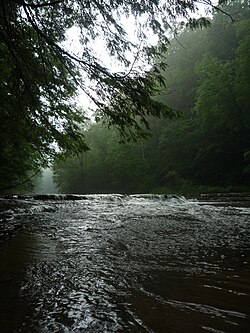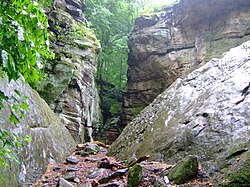Top Qs
Timeline
Chat
Perspective
Cleveland Metroparks
Public park system in Ohio, US From Wikipedia, the free encyclopedia
Remove ads
Cleveland Metroparks is an extensive system of nature preserves in Greater Cleveland, Ohio. Eighteen reservations, which largely encircle the city of Cleveland, follow along the shore of Lake Erie and the rivers and creeks that flow through the region. Referred to unofficially as the 'Emerald Necklace',[2] the network of parks spans over 25,000 acres (10,000 ha) and includes over 300 miles (480 km) of walking, bicycle, and horse trails as well as numerous picnic areas, nature education centers, golf courses, and countless fishing spots. In addition, the district includes the zoo in Cleveland. Four of the reservations are adjacent to Cuyahoga Valley National Park.
This article has multiple issues. Please help improve it or discuss these issues on the talk page. (Learn how and when to remove these messages)
|
Although the majority of the reservations are in suburban Cuyahoga County, Brookside Reservation is located within the city of Cleveland, and the Lakefront Reservation consists of several beachfront parks spanning the city's waterfront. Additionally, three of the reservations are either partially or entirely situated outside Cuyahoga County: a portion of North Chagrin Reservation is in Lake County; a small portion of Bradley Woods Reservation is in Lorain County; the Hinckley Reservation is in Hinckley Township in Medina County.[2]
The North Chagrin Reservation houses one of the only old growth forests in Northeast Ohio, the A.B. Williams Memorial Woods.[3]
The importance of conserving our natural resources is now well recognized. Cannot it be truly said that these natural wild beautiful valleys and glens which lie adjacent to our rapidly growing urban centers are a kind of 'natural resource' of ever increasing value to the public?
— William A. Stinchcomb, (speaking to the Cleveland City Council in 1909)
Remove ads
History
Summarize
Perspective
The genesis of the Cleveland Metropolitan Park System began with a vision by William Albert Stinchcomb in the early 20th century.[4] A self-taught engineer working as a surveyor for the City of Cleveland in 1895, Stinchcomb was appointed chief engineer of the City Parks Department by Mayor Tom Johnson in 1902, and shortly thereafter began to conceptualize an Emerald Necklace for the city.[5] Stinchcomb lobbied the Ohio legislature to amend the state constitution so as to permit the authorization of natural resource conservation at the county level in 1913.[6] However, the Ohio Supreme Court overturned Cuyahoga County's new park law as unconstitutional. Unflappable in his pursuit, Stinchcomb then went back to Columbus lobbying for new legislation allowing for the establishment of what was to become the Metropolitan Park District, which is today the oldest metropolitan park district in Ohio.[7]
In 1915, Stinchcomb received the break that would finally allow him to pursue his ambitious goal. While serving as Cuyahoga County engineer, he was approached by city council and offered an appointment as consulting engineer on what was eventually to become the Cleveland Metropolitan Park District board—the same board he'd lobbied for two years prior. Stinchcomb accepted and, at the urging of city council, immediately hired the renowned landscape architectural firm, the Olmsted Brothers. The group immediately went to work drawing up plans for a system of connecting parks as well as the acquisition of land and resources.[5] The proposed Cuyahoga County Park and Boulevard System, which included a parkway encircling the Cleveland area, following various creeks and rivers in the area, was the framework for what would become today's Metroparks system.[8]
Stinchcomb returned to the Statehouse in 1917, this time as an officer of the newly formed Metropolitan Park District board, and proposed a bill that would authorize the Metropolitan Park District board to levy a one-tenth mill tax to fund the district's operations. This was followed shortly after by the authorization of a second one-tenth mill tax to fund property acquisition[5] By 1921, the fledgling Park District had acquired the land that would become the Rocky River and Big Creek Reservations, most of which was donated.[5] Between 1920 and 1930, the system grew through the investment of capital from its tax levies. Purchased for approximately $4 million, land for the Hinckley, Brecksville, Bedford, South Chagrin, North Chagrin and Euclid Creek Reservations increased the district's holdings from just over 100 acres to more than 9,000 within the span of a decade.[8]
Remove ads
The Metroparks today
With free admission and almost unlimited access during daylight hours, the Metroparks' 25,000+ acres are a widely popular destination for runners, hikers, cyclists, boaters, fishermen, and nature enthusiasts. A major source of outdoor recreation in the region, official attendance figures recorded 18.5 million recreational visitors to the system's 18 reservations and the zoo in 2018, making the attraction one of the most visited in the state of Ohio.[2] The Metroparks golf courses, amenities that do exact a fee, attract over 400,000 golfers annually. With varying resources, terrains and geographical features, each park is unique. Some features, such as the toboggan chutes (also ask a fee) at Mill Stream Run Reservation's Chalet, are found nowhere else in the entire State of Ohio.[9]
Remove ads
Safety
The Cleveland Metroparks are patrolled by the Cleveland Metroparks Police Department which was founded in 1917. The departments primary goal is to provide a safe environment for the millions of visitors to the park system. Previously known as "Rangers" (c. 1959–2019), the department returned to its original 1921 title, "Police", in 2019 to better communicate the police function and law enforcement role within the communities served. Members of the department have always been fully certified police officers despite the title changes.[10] Cleveland Metroparks Police patrol the reservations and lands adjacent to, 24 hours a day, 7 days a week, enforcing both traffic, criminal, and wildlife law utilizing several specialized police units including; Motorcycle Unit, K-9 Unit, Mounted Unit, Dive Team, Detective Bureau, Bicycle Unit, Traffic Unit, Warrant Unit, Special Operations, and the Training/ Firearms/ Subject Control teams.[11]
Reservations
Remove ads
Golf Courses
Remove ads
Gallery
- Chippewa Creek in the Brecksville Reservation
- An African elephant at the Cleveland Metroparks Zoo
- Whipps Ledges at Hinckley Reservation
- Squire's Castle at the North Chagrin Reservation
- Buttermilk Falls in the North Chagrin Reservation
- A bend in the Rocky River in the Rocky River Reservation
- Shale cliffs along the Rocky River in the Rocky River Reservation
- The Chagrin River as viewed from the South Chagrin Reservation
- The Chagrin River as viewed from North Chagrin Reservation
- Water falling over the shale creek bed in Euclid Creek Reservation
- Beyer's Pond, in the Big Creek Reservation, Middleburg Heights
- The Great Falls of Tinker's Creek in the Bedford Reservation
Remove ads
See also
- Squire's Castle (North Chagrin Reservation, Willoughby Hills)
References
External links
Wikiwand - on
Seamless Wikipedia browsing. On steroids.
Remove ads













